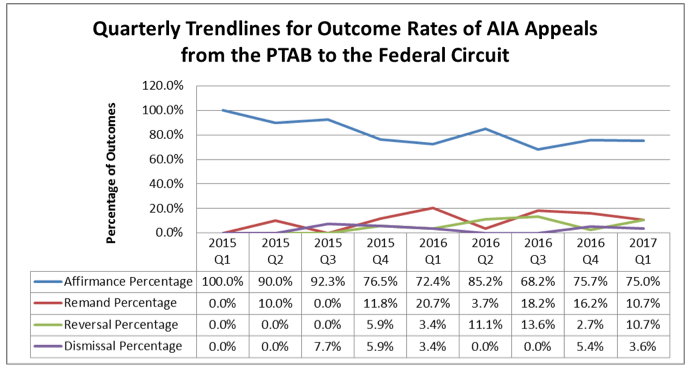 As of March 17, 2017, the Federal Circuit has remanded 23 post-grant proceedings back to the Patent Trial and Appeal Board (PTAB) for further consideration. But there are no rules governing remands: no deadlines and no set procedures. Even the Trial Practice Guide is silent. To shed some light on how the PTAB is handling remands, we analyzed these cases in detail and have spotted a few notable trends. We first provide some general statistics about appeals from post-grant proceedings to the Federal Circuit. We then discuss the types of issues remanded and discuss how the PTAB is handling them. Finally, we provide some practical takeaways.
As of March 17, 2017, the Federal Circuit has remanded 23 post-grant proceedings back to the Patent Trial and Appeal Board (PTAB) for further consideration. But there are no rules governing remands: no deadlines and no set procedures. Even the Trial Practice Guide is silent. To shed some light on how the PTAB is handling remands, we analyzed these cases in detail and have spotted a few notable trends. We first provide some general statistics about appeals from post-grant proceedings to the Federal Circuit. We then discuss the types of issues remanded and discuss how the PTAB is handling them. Finally, we provide some practical takeaways.
How many PTAB appeals to the Federal Circuit result in a remand?
To date, the Federal Circuit has issued 190 decisions on appeals from post-grant proceedings. Here is the breakdown in terms of outcomes:
- Affirmance: 78%
- Remand (at least partial): 12%
- Reversal (at least partial): 6%
- Dismissed: 3%
As illustrated in the chart below, since the last quarter of 2015, the remand rate appears to have increased, reaching as high as 20.7% in the first quarter of 2016. Consistent with this, the affirmance rate seems to be drifting downwards since its initial height of 100% back in the first quarter of 2015. One possibility is that the affirmance rate is aligning itself more closely with the affirmance rate for inter partes reexamination, which sits at 70%. Another is that the affirmance rate has leveled out at around 80%, which is notably higher than for inter partes reexamination.

Source: Sterne, Kessler, Goldstein & Fox, PLLC, Updated March 17, 2017
What issues are being remanded back to the PTAB?
Of the 23 remanded cases, we observed the following trends, in order of frequency:
- Failure to sufficiently articulate its reasoning (ten times);
- Erroneous claim construction (six times);
- Procedural violation (four times); and
- Other legal error (four times).
The predominance of remands for insufficient reasoning stands out. A review of these opinions indicates that the Federal Circuit is sending cases back to the PTAB where there is not enough reasoning for it to perform its judicial review function. Given the volume of cases before the PTAB, the number of new judges, and the statutory time-constraints under which the PTAB operates, we think that remands for lack of administrative thoroughness are likely to continue.
How is the PTAB handling remands, substantively?
To date, the Federal Circuit’s mandate has issued in 19 out of the 23 remands. Mandate shifts jurisdiction back to the PTAB for further proceedings. To date, the PTAB has resolved eight of these cases on remand. The outcomes are as follows:
- Same outcome: 50% (four of eight)
- Different outcome: 37.5% (three of eight)
- Mixed outcome: 12.5% (one decision)
It is notable that more than half of the issues resolved on remand turn out the same. One explanation is that the PTAB is, for the most part, not allowing parties to submit new evidence or make new arguments. So, in the usual case, the issues remain the same and are resolved on the same record. But there are exceptions, including one proceeding in which the panel has authorized the parties to submit new declaratory evidence and take depositions on remand. SAS Institute, Inc. v. Complementsoft, LLC, IPR2013-00226, Paper 55 (P.T.A.B. Jan. 18, 2017). Another panel has authorized the patent owner to file a supplemental motion to amend. Veeam Software Corp. v. Symantec Corp., IPR2014-00090, Paper 40 (P.T.A.B. Jan. 27, 2017).
These outcomes also depend largely on the issue being resolved. For example, where the Federal Circuit remanded for inadequate reasoning, it was more common for the PTAB to reach the same conclusion supported by more reasoning. Shaw Industries Group, Inc. v. Automated Creel Systems, Inc., IPR2013-00132, Paper 62 (P.T.A.B. Dec. 30, 2016); Corning Optical Communications RF LLC v. PPC Broadband, Inc., IPR2013-00340, Paper 89 (P.T.A.B. Nov. 16, 2016); Ariosa Diagnostics v. Verinata Health, Inc., IPR2013-00276, Paper 64 (P.T.A.B. Aug. 15, 2016). Where the Federal Circuit corrected the PTAB’s claim construction, it was more common for the result to come out differently under the proper construction. Corning Optical Communications RF, LLC v. PPC Broadband, Inc., IPR2013-00342, Paper 57 (P.T.A.B. Oct. 12, 2016); Sipnet EU S.R.O. v. Straight Path IP Group, Inc., IPR2013-00246, Paper 73 (P.T.A.B. May 23, 2016). Similarly, where the PTAB relied on something that caused a procedural violation, the PTAB set aside the offending argument or evidence and came out differently. Dell Inc. v. Acceleron, LLC, IPR2013-00440, Paper 49 (P.T.A.B. Aug. 22, 2016).
How is the PTAB handling remands, procedurally?
The remand proceeding begins after the Federal Circuit issues its mandate. The PTAB does not have jurisdiction until then. From that point onwards, the timeline for resolution varies widely – from 3.5 months to 7.7 months, with one decision still outstanding at 11.4 months. The median pendency on remand, so far, is 6.3 months and the average is 6.4 months.
Presently, procedures on remand are panel-dependent, and their scope is defined by the error identified by the Federal Circuit. In a typical case, one or both parties initiate the remand decision-making process by requesting a conference call with the PTAB. During the call, the parties advocate for what kind of briefing, if any, they believe is justified. The PTAB then issues an order setting forth the briefing schedule, and any additional parameters including timing and so forth. To the extent briefing is authorized, panels vary in terms of the amount (ranging from 5-15 pages in length), in terms of submission format (simultaneously submitted or sequentially, with reply briefing only when requested or pre-authorized), and in terms of the timing (due anywhere from less than a week to over a month). As mentioned, one panel has allowed the parties to submit additional declaratory evidence and take associated cross-examination, which complicates the briefing schedule somewhat. Some panels list specific issues to be addressed in the briefing, others leave the topic open-ended, e.g., the “impact” of the Court’s decision.
What do we know about remands that we did not know before?
Remands do not appear to have been contemplated by the statutory framework for post-grant proceedings. For example, while the statute gives the PTAB a one-year deadline to complete a trial and creates a right of appeal to the Federal Circuit, it does not speak directly to whether that deadline applies to remands. What the PTAB has said so far in the remands decided to date provides some, but not complete, clarity. For example, the PTAB does not see itself as under any statutory deadline for issuing a new final written decision on remand. Microsoft Corporation v. Proxyconn, Inc., IPR2012-00026, Paper 80 (P.T.A.B. Dec. 9, 2015). In the briefing before the Federal Circuit, Proxyconn argued that a remand in that case would violate the statute because the maximum time allowed (18 months) had already expired. While the Federal Circuit explored the topic somewhat during the oral argument, its opinion was silent.
Second, we know that the PTAB believes that it can stay proceedings on remand pending a decision on a cert petition to the Supreme Court. Shaw Industries Group, Inc. v. Automated Creel Systems, Inc., IPR2013-00132, Paper 60 (P.T.A.B. Oct. 14, 2016). That said, the PTAB also believes it has discretion not to stay proceedings. SAS Institute, Inc. v. Complementsoft, LLC, IPR2013-00226, Paper 48 (P.T.A.B. Dec. 15, 2016) (declining to stay remand proceedings pending a decision on a cert petition, finding some issues on remand to be independent).
Third, the PTAB appears to contemplate that its decision on remand is itself appealable. In the remand decisions issued to date, the PTAB directs parties to the regulations governing notices of appeal. At least two notices of appeal have been filed in remand decisions to date.
What are the practical takeaways from remands decided to-date?
We end with three practical takeaways:
- Be proactive. If you desire speedy resolution on remand, reach out to the opposing party (if there is one) and jointly initiate a call with the PTAB soon after the Court issues its mandate. The PTAB does not seem inclined to act on its own.
- Be creative. Since there are no fixed rules, review the Federal Circuit’s decision carefully, determine what relief you may be entitled to, and then devise a plan to best assist the PTAB in resolving the case.
- Be assertive. Go the PTAB with a definitive plan. After discussing potential parameters with opposing counsel, at a minimum, consider asking for supplemental briefing to assist the PTAB in understanding the issues and resolve the case. Have a proposal for timing, page limits, scope limits, deadlines, perhaps a proposed order, etc.

![[IPWatchdog Logo]](https://ipwatchdog.com/wp-content/themes/IPWatchdog%20-%202023/assets/images/temp/logo-small@2x.png)


![[Advertisement]](https://ipwatchdog.com/wp-content/uploads/2024/04/Patent-Litigation-Masters-2024-sidebar-early-bird-ends-Apr-21-last-chance-700x500-1.jpg)

![[Advertisement]](https://ipwatchdog.com/wp-content/uploads/2021/12/WEBINAR-336-x-280-px.png)
![[Advertisement]](https://ipwatchdog.com/wp-content/uploads/2021/12/2021-Patent-Practice-on-Demand-recorded-Feb-2021-336-x-280.jpg)
![[Advertisement]](https://ipwatchdog.com/wp-content/uploads/2021/12/Ad-4-The-Invent-Patent-System™.png)







Join the Discussion
One comment so far.
Eric Berend
March 22, 2017 07:39 amWhile some may characterize the PTAB as a ‘kangeroo court’; the reality on the ground, shows that this is valuable information for patent owners and practitioner counsel. Thank you both, for publishing this worthwhile research in such an important emerging area of practice.